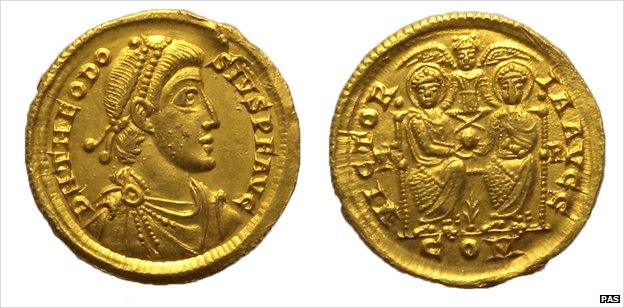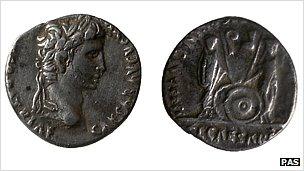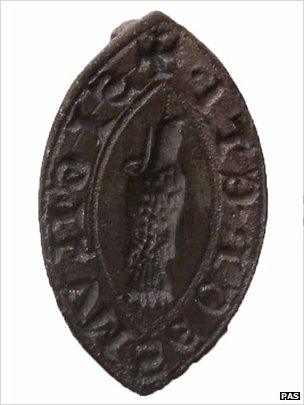Roman gold coin revealed in 'lucky' Norfolk treasure find
- Published

The gold solidus features Emperor Theodosius I who ruled from 379-395 AD
A hoard of Roman gold and silver coins, described by an expert as a "lucky" find, have been discovered in Norfolk.
The gold solidus, found by a metal detector enthusiast in a field near Norwich, is thought to have been dropped or buried circa AD 410.
Adrian Marsden, a coin expert based at Norwich Castle Museum, said: "We see very few Roman gold coins. It would have a spending power of about £1,000."
The hoard was among a number of items declared treasure, external in April.
"This is a very late Roman coin hoard," said Mr Marsden.
"The mixture of gold and silver does happen, it's very similar to the hoard found in Hoxne in terms of the mix, they just had many more.

The hoard of 59 silver denarii were found south of Norwich
"We see very few Roman gold coins, just two or three a year if we're lucky. It could be a purse loss, or there's always the chance they are part of a much bigger pot."
Items also declared treasure by Norfolk's assistant deputy coroner David Osborne included an Anglo-Saxon silver pin found in Scoulton, a Middle Bronze Age Gold Bead discovered in Salthouse and a hoard of 59 silver Roman coins that date from the Roman Republic to Tiberius, the second emperor of Rome.
'Loyal friend'
"As this hoard finishes with the coins of Tiberius, it could date to either the Roman invasion of Britain in AD 43, or possibly the Boudicca revolt in AD 61, it's difficult to say either way," said Mr Marsden.
"It's likely it was buried to have come from a Roman soldier or perhaps settlers trying to hide their hoard from the Iceni invasion. We tend not to see many of this type of Roman silver coins, so to have 59 is really quite unusual.
"Coins this size have a spending power of about £30-£40 in today's money - it'd certain buy a soldier a few jugs of wine."

Medieval silver seal matrix
A medieval gold pendant found in Foxley and a medieval silver seal matrix unearthed in Sustead, near Cromer, were also declared treasure.
Erica Darch, from Norfolk Historic Environment Services, external and the Portable Antiquities Scheme (PAS), said: "It's important to record all archaeological finds, treasure or not, because when studied as an assemblage they add enormously to our understanding of Norfolk's past.
"Medieval 13-14th Century seal matrices are not unusual finds, although they are more commonly found in copper alloy and lead than silver and consist of an inscription around a central image.
"They often bear the name of the owner and sometimes other information such as the name of their father or a surname - for example 'Seal of Joan daughter of William' or 'Seal of Marriott Good'.
"Others, like this one, have appropriate but non-personal inscriptions, for example lel ami avet - you have a loyal friend. Religious inscriptions were also popular."
- Published1 April 2013
- Published8 December 2012
- Published26 November 2012
- Published18 October 2012